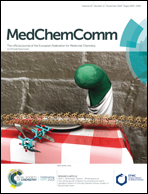Methyl sulfonamide substituents improve the pharmacokinetic properties of bicyclic 2-pyridone based Chlamydia trachomatis inhibitors
Abstract
Chlamydia trachomatis infections are a global health problem and new approaches to treat C. trachomatis with drugs of high specificity would be valuable. A library of substituted ring fused 2-pyridones has been synthesized and evaluated for their ability to attenuate C. trachomatis infectivity. In vivo pharmacokinetic studies were performed, with the best candidates demonstrating that a C8-methylsulfonamide substituent improved pharmacokinetic properties important for oral administration. C8-Methyl sulfonamide analogue 30 inhibited C. trachomatis infectivity in low micromolar concentrations. Further pharmacokinetic evaluation at an oral dose of 10 mg kg−1 showed an apparent bioavailability of 41%, compared to C8-cyclopropyl and -methoxy analogues which had negligible oral uptake. In vitro ADME (absorption, distribution, metabolism and excretion) testing of solubility and Caco-2 cell permeability revealed that both solubility and permeability is greatly improved with the C8-methyl sulfonamide 30, effectively moving it from BCS (Biopharmaceutical Classification System) class IV to II.



 Please wait while we load your content...
Please wait while we load your content...